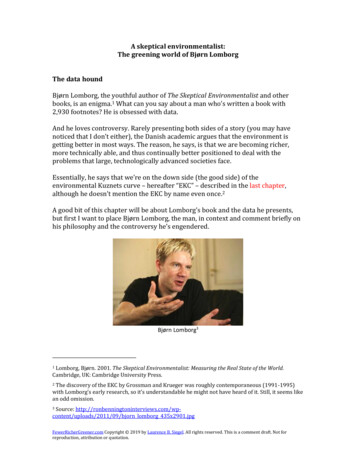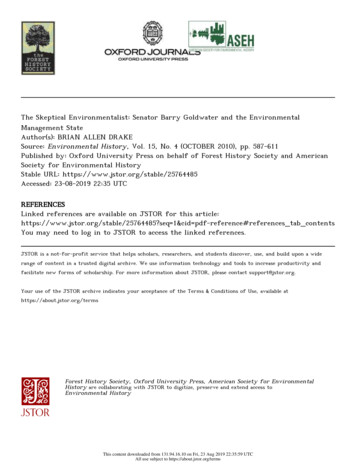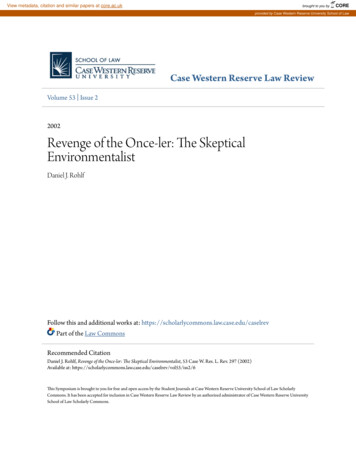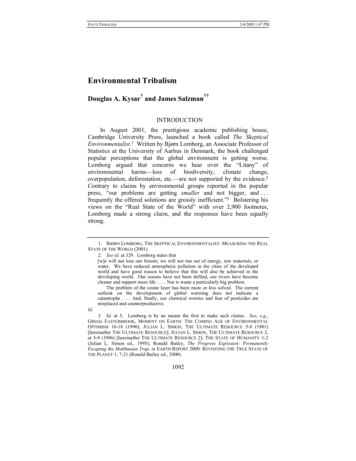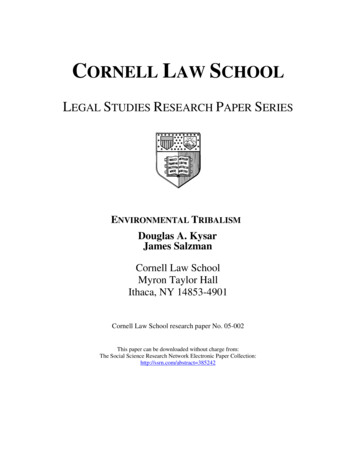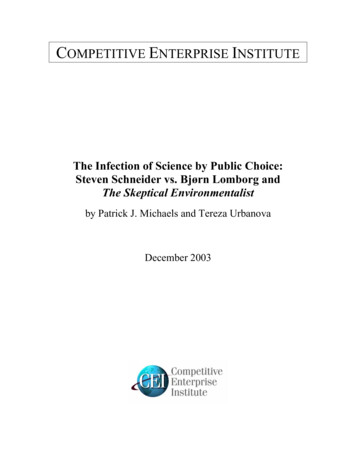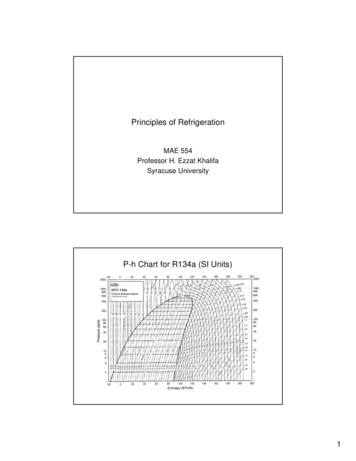
Transcription
Given the recent debate in our pages over global warming and climate change, we invited Bjorn Lomborg, author of CoolIt! The Skeptical Environmentalist’s Guide to Global Warming, for his perspective. — EDITORLet’s Keep Our Cool aboutGlobal WarmingB JORN LOM BORGWhen it comes to climate change, we need to cool our dialogue and consider the arguments for andagainst different policy options. In the heat of a loud and obnoxious debate, facts and reason lose out.PUDIM CARTOONGOES HERE. COMING SOON!X42Vol ume 32 , I ssue 2 S KE P T IC AL INQUIR E R
There is a kind of choreographedscreaming about climate change fromboth sides of the debate. Discussionwould be on much firmer ground if we couldactually hear the arguments and the facts andthen sensibly debate long-term solutions.Man-made climate change is certainly a problem, but it iscategorically not the end of the world. Take the rise in sea levelsas one example of how the volume of the screaming is unmatchedby the facts. In its 2007 report, the United Nations estimates thatsea levels will rise about a foot over the remainder of the century.1While this is not a trivial amount, it is also important to realizethat it is not unknown to mankind: since 1860, we have experienced a sea level rise of about a foot without major disruptions.2It is also important to realize that the new prediction is lower thanprevious Intergovernmental Panel on Climate Change (IPCC)estimates and much lower than the expectations from the 1990sof more than two feet and the 1980s, when the EnvironmentalProtection Agency projected more than six feet.3We dealt with rising sea levels in the past century, and we willcontinue to do so in this century. It will be problematic, but it isincorrect to posit the rise as the end of civilization.We will actually lose very little dry land to the rise in sea levels.It is estimated that almost all nations in the world will establishmaximal coastal protection almost everywhere, simply becausedoing so is fairly cheap. For more than 180 of the world’s 192nations, coastal protection will cost less than 0.1 percent GDPand approach 100 percent protection.4The rise in sea level will be a much bigger problem for poorcountries. The most affected nation will be Micronesia, a federation of 607 small islands in the West Pacific with a total land areaonly four times larger than Washington, D.C.5 If nothing weredone, Micronesia would lose some 21 percent of its area by theend of the century (Tol 2004, 5). With coastal protection, it willlose just 0.18 percent of its land area. However, if we instead optfor cuts in carbon emissions and thus reduce both the sea level riseand economic growth, Micronesia will end up losing a larger landarea. The increase in wealth for poor nations is more importantthan sea levels: poorer nations will be less able to defend themselves against rising waters, even if they rise more slowly. Thisis the same for other vulnerable nations: Tuvalu, the Maldives,Vietnam, and Bangladesh.The point is that we cannot just talk about CO2 when we talkabout climate change. The dialogue needs to include both considerations about carbon emissions and economics for the benefit ofhumans and the environment. Presumably, our goal is not just tocut carbon emissions, but to do the best we can for people andthe environment.We should take action on climate change, but we need to berealistic. The U.K has arguably engaged in the most aggressiverhetoric about climate change. Since the Labour governmentpromised in 1997 to cut emissions by a further 15 percent by2010, emissions have increased 3 percent.6 American emissionsduring the Clinton/Gore administration increased 28 percent.Look at our past behavior: at the Earth Summit in Rio in1992, nations promised to cut emissions back to 1990 levelsby 2000 (UNFCCC 1992, 4.2a). The member countries ofthe Organisation for Economic Cooperation and Development (OECD) overshot their target in 2000 by more than12 percent.Many believe that dramatic political action will follow if people only knew better and elected better politicians.7 Despite theEuropean Union’s enthusiasm for the Kyoto Protocol on ClimateChange—and a greater awareness and concern over global warming in Europe than in the United States—emissions per personsince 1990 have remained stable in the U.S. while E.U. emissionshave increased 4 percent (EIA 2006).Even if the wealthy nations managed to reign in their emissions, the majority of this century’s emissions will come fromdeveloping countries—which are responsible for about 40 per-Funding research and developmentglobally would create a momentumthat could recapture the vision ofdelivering both a low-carbon andhigh-income world.cent of annual carbon emissions; this is likely to increase to 75percent by the end of the century.8In a surprisingly candid statement from Tony Blair at theClinton Global Initiative, he pointed out:I think if we are going to get action on this, we have got to startfrom the brutal honesty about the politics of how we deal with it.The truth is no country is going to cut its growth or consumptionsubstantially in the light of a long-term environmental problem.What countries are prepared to do is to try to work togethercooperatively to deal with this problem in a way that allows us todevelop the science and technology in a beneficial way. (ClintonGlobal Initiative 2005, 15)Similarly, one of the top economic researchers tells us: “Deep cutsin emissions will only be achieved if alternative energy technologies become available at reasonable prices” (Tol 2007, 430). Weneed to engage in a sensible debate about how to tax CO2. If weset the tax too low, we emit too much. If we set it too high, weend up much poorer without doing enough to reduce warming.In the largest review of all of the literature’s 103 estimates,climate economist Richard Tol makes two important points.Bjorn Lomborg, PhD, is an adjunct professor in the CopenhagenBusiness School and organizer of the Copenhagen Consensus, aconference of top economists who come together to prioritize thebest solutions for the world’s greatest challenges. He is author ofThe Skeptical Environmentalist and, most recently, Cool It!The Skeptical Environmentalist’s Guide to Global Warming.SKEPTICA L IN QU IRER M a r c h / Apr i l 2 0 0 8 4 3
Former Prime Minister Tony Blair appeared at the Clinton Global Initiativeannual meeting in New York City. Photo credit: Janet Mayer/Splash News.[Photo via Newscom]First, the really scary, high estimates typically have not been subjected to peer review and published. In his words: “studies withbetter methods yield lower estimates with smaller uncertainties.”Second, with reasonable assumptions, the cost is very unlikely tobe higher than 14 per ton of CO2 and likely to be much smaller(Tol 2005).9 When I specifically asked him for his best guess, hewasn’t too enthusiastic about shedding his cautiousness—as fewtrue researchers invariably are—but gave the estimate of 2 perton of CO2.10Therefore, I believe that we should tax CO2 at the economically feasible level of about 2/ton, or maximally 14/ton. Yet,let us not expect this will make any major difference. Such a taxwould cut emissions by 5 percent and reduce temperatures by0.16 F. And before we scoff at 5 percent, let us remember that theKyoto protocol, at the cost of 10 years of political and economictoil, will reduce emissions by just 0.4 percent by 2010.11Neither a tax nor Kyoto nor draconian proposals for futurecuts move us closer toward finding better options for the future.Research and development in renewable energy and energy effi44Vol ume 32 , I ssue 2 S KE P T IC AL INQUIR E Rciency is at its lowest for twenty-five years. Instead, we need tofind a way that allows us to “develop the science and technologyin a beneficial way,” a way that enables us to provide alternativeenergy technologies at reasonable prices. It will take the betterpart of a century and will need a political will spanning parties,continents, and generations. We need to be in for the long hauland develop cost-effective strategies that won’t splinter regardlessof overarching ambitions or false directions.This is why one of our generational challenges should be forall nations to commit themselves to spending 0.05 percent of GDP inresearch and development of noncarbon emitting energy technologies.This is a tenfold increase on current expenditures yet would costa relatively minor 25 billion per year (seven times cheaper thanKyoto and many more times cheaper than Kyoto II). Such a commitment could include all nations, with wealthier nations payingthe larger share, and would let each country focus on its ownfuture vision of energy needs, whether that means concentratingon renewable sources, nuclear energy, fusion, carbon storage,conservation, or searching for new and more exotic opportunities.Funding research and development globally would create amomentum that could recapture the vision of delivering both alow-carbon and high-income world. Lower energy costs and highspin-off innovation are potential benefits that possibly avoid everstronger temptations to free-riding and the ever tougher negotiations over increasingly restrictive Kyoto Protocol-style treaties.A global financial commitment makes it plausible to envisionstabilizing climate changes at reasonable levels.I believe it would be the way to bridge a century of parties,continents, and generations, creating a sustainable, low-costopportunity to create the alternative energy technologies that willpower the future.To move toward this goal we need to create sensible policydialogue. This requires us to talk openly about priorities. Oftenthere is strong sentiment in any public discussion that we shoulddo anything required to make a situation better. But clearly wedon’t actually do that. When we talk about schools, we knowthat more teachers would likely provide our children with a bettereducation.12 Yet we do not hire more teachers simply because wealso have to spend money in other areas. When we talk abouthospitals, we know that access to better equipment is likely toprovide better treatment, yet we don’t supply an infinite amountof resources.13 When we talk about the environment, we knowtougher restrictions will mean better protection, but this alsocomes with higher costs.Consider traffic fatalities, which are one of the ten leadingcauses of deaths in the world. In the U.S., 42,600 people diein traffic accidents and 2.8 million people are injured each year(USCB, 2006, 672). Globally, it is estimated that 1.2 millionpeople die from traffic accidents and 50 million are injured everyyear (Lopez, Mathers, Ezzati, Jamison, and Murray 2006, 1751;WHO 2002, 72; 2004, 3, 172).About 2 percent of all deaths in the world are traffic-relatedand about 90 percent of the traffic deaths occur in third worldcountries (WHO 2004, 172). The total cost is a phenomenal 512 billion a year (WHO 2004, 5). Due to increasing traffic(especially in the third world) and due to ever better health con-
ditions, the World Heath Organization estimates that by 2020,traffic fatalities will be the second leading cause of death in theworld, after heart disease.14Amazingly, we have the technology to make all of this go away.We could instantly save 1.2 million humans and eliminate 500billion worth of damage. We would particularly help the thirdworld. The answer is simply lowering speed limits to 5 mph. Wecould avoid almost all of the 50 million injuries each year. But ofcourse we will not do this. Why? The simple answer that almostall of us would offer is that the benefits from driving moderatelyfast far outweigh the costs. While the cost is obvious in terms ofthose killed and maimed, the benefits are much more prosaicand dispersed but nonetheless important—traffic interconnectsour society by bringing goods at competitive prices to where welive and bringing people together to where we work, and lets uslive where we like while allowing us to visit and meet with manyothers. A world moving only at 5 mph is a world gone medieval.This is not meant to be flippant. We really could solve one ofthe world’s top problems if we wanted. We know traffic deathsare almost entirely caused by man. We have the technology toreduce deaths to zero. Yet we persist in exacerbating the problemeach year, making traffic an ever-bigger killer.I suggest that the comparison with global warming is insightful; we have the technology to reduce it to zero, yet we seem topersist in going ahead and exacerbating the problem each year,causing temperatures to continue to increase to new heights by2020. Why? Because the benefits from moderately using fossilfuels far outweigh the costs. Yes, the costs are obvious in the “fear,terror, and disaster” we read about in the papers every day.But the benefits of fossil fuels, though much more prosaic,are nonetheless important. Fossil fuels provide us with low-costelectricity, heat, food, communication, and travel.15 Electricalair conditioning means that people in the U.S. no longer die indroves during heat waves (Davis, Knappenberger, Michaels, andNovicoff 2003). Cheaper fuels would have avoided a significantnumber of the 150,000 people that have died in the UK since2000 due to cold winters.16Because of fossil fuels, food can be grown cheaply, givingus access to fruits and vegetables year round, which has probably reduced cancer rates by at least 25 percent.17 Cars allow usto commute to city centers for work while living in areas thatprovide us with space and nature around our homes, whereascommunication and cheap flights have given ever more peoplethe opportunity to experience other cultures and forge friendshipsglobally (Schäfer 2006).In the third world, access to fossil fuels is crucial. About 1.6billion people don’t have access to electricity, which seriouslyimpedes human development (IEA 2004, 338–40). Worldwide,about 2.5 billion people rely on biomass such as wood and waste(including dung) to cook and keep warm (IEA 2006, 419ff). Formany Indian women, searching for wood takes about three hourseach day, and sometimes they walk more than 10 kilometers aday. All of this causes excessive deforestation (IEA 2006, 428;Kammen 1995; Kelkar 2006). About 1.3 million people—mostlywomen and children—die each year due to heavy indoor air pollution. A switch from biomass to fossil fuels would dramaticallyimprove 2.5 billion lives; the cost of 1.5 billion annually wouldbe greatly superseded by benefits of about 90 billion.18 Both forthe developed and the developing world, a world without fossilfuels—in the short or medium term—is, again, a lot like revertingback to the middle ages.This does not mean that we should not talk about how toreduce the impact of traffic and global warming. Most countrieshave strict regulation on speed limits—if they didn’t, fatalitieswould be much higher. Yet, studies also show that loweringthe average speed in Western Europe by just 5 kilometers perhour could reduce fatalities by 25 percent—with about 10,000fewer people killed each year (WHO, 2002, 72; 2004, 172).Apparently, democracies in Europe are not willing to give up onthe extra benefits from faster driving to save 10,000 people.This is parallel to the debate we are having about globalwarming. We can realistically talk about 2 or even a 14 CO2tax. But suggesting a 140 tax, as Al Gore does, seems to be faroutside the envelope. Suggesting a 96 percent carbon reductionfor the OECD by 2030 seems a bit like suggesting a 5 mph speedlimit in the traffic debate. It is technically doable, but it is veryunlikely to happen.One of the most important issues when it comes to climatechange is that we cool our dialogue and consider the argumentsfor and against different policies. In the heat of a loud and obnoxious debate, facts and reason lose out.Notes1. (IPCC, 2007b:10.6.5). Notice that the available report (IPCC 2007a) hasa midpoint of 38.5cm.2. Using (Jevrejeva, Grinsted, Moore, and Holgate 2006), 11.4 inches since1860.3. 1996: 38–35cm (IPCC and Houghton, 1996:364), 1992 and 1983 EPAfrom Yohe and Neumann 1997, 243; 250.4. (Nicholls and Tol 2006, 1088), estimated for 2085. Notice, low-lyingundeveloped coasts in places such as Arctic Russia, Canada and Alaska areexpected to be undefended. Notice that the numbers presented are for loss of dryland, whereas up to 18 percent of global wetlands will be lost.5. “Micronesia” (CIA 2006).6. Labour has urged a 20 percent CO2 emission cut from 1990 in 2010 inthree election manifestos (BBC Annon., 2006a); this translates into a 14.6 percentreduction from 1997-levels. From 1997 to 2004, CO2 emissions increased 3.4percent (EIA, 2006).7. Take, for instance, both Gore’s “we have to find a way to communicatethe direness of the situation” and Hansen’s “scientists have not done a good jobcommunicating with the public” (Fischer 2006).8. Developing countries emitted 10.171Gt of the global 26Gt in 2004(IEA, 2006, 513, 493) (OECD countries 51 percent in 2003 (OECD 2006,148), Weyant estimates 29 percent from industrialized countries (1998, 2286),IPCC emission scenarios from 23 in the business-as-usual A1 to 36 percent(Nakicenovic and IPCC WG III 2000).9. Based on a cost of 50 per ton of carbon (Tol 2005:2071).10. From the Environmental Assessment Institute we asked him in July 2005:“Would you still stick by the conclusion that 15/tC seems justified or would yourather only present an upper limit of the estimate?” He answered: “I’d prefer notto present a central estimate, but if you put a gun to my head I would say 7/tC, the median estimate with a 3 percent pure rate of time preference” ( 7/tC 1.9/tCO2). This is comparable with Pearce’s estimate of 1–2.5/tCO2 ( 4–9/tC) (2003:369).11. There are many advantages to taxes over emission caps, mainly thatwith taxes, authorities have an interest in collecting them (because it funds thegovernment), whereas with caps, individual countries have much less interest inachieving goals with such an effort, because the benefits are dispersed (global) andthe damages localized (to local industries).12. (Akerhielm 1995; Angrist and Lavy 1999; Graddy and Stevens 2005).Of course, this could be modified in many ways, such as by focusing on payingSKEPTICA L IN QU IRER M a r c h / Apr i l 2 0 0 8 4 5
teachers better, more resources for books, computers, etc. It is also importantthat we should be saying “more teachers will at least not make schools worse andwill likely make them better,” as most studies show some or no effect from extraresources but very few show negative results.13. E.g., (Fleitas et al. 2006; Gebhardt and Norris 2006). On the other hand,it is less clear that (after a certain limit) more doctors and bed space is the answer,since they may just make for more visits and increase the possibility of infectionsand harm (Weinberger, Oddone, and Henderson 1996; Wennberg et al. 2004).14. (WHO 2002, 129) puts it second, whereas (WHO 2004, 5) puts it third.15. This only looks at the marginal benefit of fossil fuels—which is the relevant one for our discussion. On a basic level, though, it is important to rememberthat they have fundamentally changed our lives. Before fossil fuels, we wouldspend hours gathering wood, contributing to deforestation and soil erosion—asbillions in the third world still do today (Kammen 1995). We have electric washing machines that have cut domestic work dramatically. The historical economistStanley Lebergott wrote only semi-jokingly: “From 1620 to 1920 the Americanwashing machine was a housewife” (Lebergott 1993, 112). In 1900, a housewifespent seven hours a week laundering, carrying 200 gallons of water into thehouse and using a scrub board. Today, she spends 84 minutes with much lessstrain (Robinson and Godbey 1997, 327). We have a fridge that has both givenus more spare time and allowed us to avoid rotten food and eat a more healthydiet of fruit and vegetables (Lebergott 1995, 155). By the end of the nineteenthcentury human labor made up 94 percent of all industrial work in the U.S. Today,it constitutes only 8 percent (Berry, Conkling, Ray, and Berry 1993, 131). If wethink for a moment of the energy we use in terms of “servants,” each with thesame work power as a human being, each person in Western Europe has access to150 servants, in the U.S. about 300, and even in India each person has 15 servantsto help (Craig, Vaughan, and Skinner 1996:103).16. Steve Jones, “Help the Aged,” said: “Many pensioners still agonize aboutwhether or not to heat their homes in the cold weather. In the world’s fourthrichest country, this is simply shameful” (BBC Annon. 2006b).17. The World Cancer Research Fund study estimates that increasing theintake of fruit and vegetables from an average of about 250 g/day to 400 g/daywould reduce, the overall frequency of cancer by around 23 percent (WCRF1997:540).18. Mainly from fewer deaths and less time use.ReferencesAkerhielm, K. 1995. Does class size matter? Economics of Education Review 14(3),229–41.Angrist, J.D., and V. Lavy. 1999. Using Maimonides’ rule to estimate the effectof class size on scholastic achievement. Quarterly Journal of Economics 114(2),533–75.BBC Annon. 2006a, March 28. UK to miss CO2 emissions target. BBC. Availableat stm. Accessed January29, 2007.———. 2006b, October 27. ‘Winter death toll’ drops by 19%: Deathsin England and Wales fell to 25,700 last winter, a decline of 19% onthe previous year. BBC Web site. Available at http://news.bbc.co.uk/2/hi/uk news/6090492.stm. Accessed November 13, 2006.Berry, B.J.L., E.C. Conkling, and D.M. Ray. 1993. The Global Economy: ResourceUse, Locational Choice, and international trade. Englewood Cliffs, N.J.:Prentice-Hall.CIA. 2006. CIA World Fact Book. Central Intelligence Agency, December 12.Clinton Global Initiative. 2005, September 15. Special Opening Plenary Session:Perspectives on the Global Challenges of Our Time. Available at scripts/plenary/cgi 09 15 05 plenary 1.pdf. Accessed January 29, 2007.Craig, J.R., D.J. Vaughan, and B.J. Skinner. 1996. Resources of the Earth: Origin,Use and Environmental Impact. Upper Saddle River, N.J.: Prentice Hall.Davis, R.E., P.C. Knappenberger, P.J. Michaels, and W.M.Novicoff. 2003.Changing heat-related mortality in the United States. Environmental HealthPerspectives 111(14), 1712–18.EIA. 2006. International Energy Annual 2004. Energy Information Agency.Available at http://www.eia.doe.gov/iea/. Accessed November 30, 2006.Fischer, D. 2006, December 15. Gore urges scientists to speak up. ContraCosta Times. Available at gi/67/24524. Accessed January 29, 2007.Fleitas, I., et al. 2006. The quality of radiology services in five Latin Americancountries. Revista Panamericana De Salud Publica-Pan American Journal ofPublic Health 20(2–3), 113–24.Gebhardt, J.G., and T.E. Norris 2006. Acute stroke care at rural hospitals inIdaho: Challenges in expediting stroke care. Journal of Rural Health 22(1),88–91.46Vol ume 32 , I ssue 2 S KE P T IC AL INQUIR E RGraddy, K., and M.Stevens. 2005. The impact of school resources on studentperformance: A study of private schools in the United Kingdom. Industrial &Labor Relations Review 58(3), 435–51.IEA. 2004. World Energy Outlook 2004: IEA Publications.———. 2006. World Energy Outlook 2006: IEA Publications.IPCC. 2007a. Climate Change 2007: WGI: Summary for Policymakers.———. 2007b. Climate Change 2007: WGI: The Physical Science Basis. Cambridge (UK): Cambridge University Press.IPCC and J.T. Houghton. 1996. Climate Change 1995: The Science of ClimateChange. Cambridge, New York: Cambridge University Press.Jevrejeva, S., A. Grinsted, J.C. Moore, and S. Holgate. 2006. Nonlinear trendsand multiyear cycles in sea level records. Journal of Geophysical Research-Oceans111(C9).Kammen, D.M. 1995. Cookstoves for the Developing-World. Scientific American273(1), 72–75.Kelkar, G. 2006, May 8. The Gender Face of Energy. Presentation at CSD14 Learning Centre, United Nations. Available at ation/gender2.pdf. Accessed January 30, 2007.Lebergott, S. 1993. Pursuing Happiness: American Consumers in the TwentiethCentury. Princeton, N.J.: Princeton University Press.———. 1995. Long-term trends in the US standard of living. In J. Simon (Ed.),State of Humanity (pp. 149–60). Oxford: Blackwell.Lopez, A.D., C.D. Mathers, M. Ezzati, D.T. Jamison, and C.J.L. Murray. 2006.Global and regional burden of disease and risk factors, 2001: systematic analysis of population health data. Lancet 367(9524), 1747–57.Nakicenovic, N., and IPCC WG III. 2000. Special Report on Emissions Scenarios:a Special Report of Working Group III of the Intergovernmental Panel on ClimateChange. Cambridge, New York: Cambridge University Press.Nicholls, R.J., and R.S.J. Tol. 2006. Impacts and responses to sea-level rise:a global analysis of the SRES scenarios over the twenty-first century.Philosophical Transactions of the Royal Society A—Mathematical Physical andEngineering Sciences 364(1841), 1073–95.OECD. 2006. OECD factbook 2006 (p. v.). Paris: Organization for EconomicCo-operation and Development.Pearce, D. 2003. The social cost of carbon and its policy implications. OxfordReview of Economic Policy 19(3), 362–84.Robinson, J.P., and G. Godbey. 1997. Time for Life: The Surprising Ways AmericansUse Their Time. University Park, PA.: Pennsylvania State University Press.Schäfer, A. 2006. Long-term trends in global passenger mobility. Bridge 36(4),24–32.Tol, R.S.J. 2004. The double trade-off between adaptation and mitigation forsea level rise: an application of FUND. Hamburg University and Centre forMarine and Atmospheric Science, Hamburg.———. 2005. The marginal damage costs of carbon dioxide emissions: An assessment of the uncertainties. Energy Policy 33(16), 2064–74.———. 2007. Europe’s long-term climate target: A critical evaluation. EnergyPolicy 35(1), 424–32.UNFCCC. 1992. United Nations Framework Convention on Climate Change:United Nations Framework Convention on Climate Change.USCB. 2006. Statistical Abstract of the United States: 2007. U.S. CensusBureau. Available at t.html. Accessed January 30, 2007.WCRF. 1997. Food, Nutrition and the Prevention of Cancer: A Global Perspective.Washington, D.C.: World Cancer Research Fund & American Institute forCancer Research.Weinberger, M., E.Z. Oddone, and W.G. Henderson. 1996. Does increasedaccess to primary care reduce hospital readmissions? New England Journal ofMedicine 334(22), 1441–47.Wennberg, J.E., et al. 2004. Use of hospitals, physician visits, and hospice careduring last six months of life among cohorts loyal to highly respected hospitalsin the United States. British Medical Journal 328(7440), 607–610A.WHO. 2002. The world health report 2002—reducing risk, promoting healthylife. World Health Organization.———. 2004. World report on road traffic injury prevention: World HealthOrganization.Wigley, T.M.L. 1998. The Kyoto Protocol: CO2, CH4 and climate implications.Geophysical Research Letters 25(13), 2285–88.Yohe, G., and J. Neumann. 1997. Planning for sea level rise and shore protectionunder climate uncertainty. Climatic Change 37(1), 243–70.!
The Skeptical Environmentalist's Guide to Global Warming, for his perspective. — EDITOR Let's Keep Our Cool about Global Warming BJORN LOMBORG When it comes to climate change, we need to cool our dialogue and consider the arguments for and against different policy options. In the heat of a loud and obnoxious debate, facts and reason lose out.


